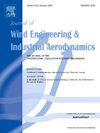Converting dependence of extreme wind pressure coefficients across different epochs
IF 4.2
2区 工程技术
Q1 ENGINEERING, CIVIL
Journal of Wind Engineering and Industrial Aerodynamics
Pub Date : 2024-11-13
DOI:10.1016/j.jweia.2024.105947
引用次数: 0
Abstract
The dependence of extreme wind pressure coefficients has gained attention due to its potential impact on determining design wind loads and assessing wind-induced damages of cladding components. However, experimental data with short durations often fail to provide a sufficient number of extreme samples of pressure coefficients over specified epochs (e.g., 10 min or 1 h). Consequently, estimating the dependence of extreme pressure coefficients remains a challenge. To address this issue, Spearman's ρ is employed to quantify the dependence of extreme pressure coefficients due to their non-Gaussianity nature, based on which a theoretical formula converting the dependence of extreme pressure coefficients across different epochs is deduced. Furthermore, a simplified conversion formula, which offers accuracy equivalent to the theoretical one while enhancing efficiency, is provided. A dataset of pressure coefficients with a very long duration is employed for formula examination. The conversion formula demonstrates good agreement with the observed trend of dependence between extreme pressure coefficients over different epochs. Error analysis is also conducted to investigate the uncertainty of estimates from data. Additionally, the efficacy of the conversion formula deduced based on Pearson's linear correlation coefficient is discussed.
不同年代极端风压系数的换算关系
由于极端风压系数对确定设计风荷载和评估风引起的覆层部件损坏具有潜在影响,因此其依赖性已受到关注。然而,持续时间较短的实验数据往往无法提供指定时间段(如 10 分钟或 1 小时)内足够数量的极端压力系数样本。因此,估计极端压力系数的依赖性仍然是一个挑战。为了解决这个问题,我们采用了斯皮尔曼 ρ 来量化极端压力系数的非高斯依赖性,并在此基础上推导出不同时间段极端压力系数依赖性的理论换算公式。此外,还提供了一个简化的转换公式,在提高效率的同时提供了与理论公式相当的精度。公式检验采用了一个持续时间很长的压力系数数据集。转换公式与观测到的不同时间段极端压力系数之间的依赖趋势非常吻合。同时还进行了误差分析,以研究数据估计值的不确定性。此外,还讨论了根据皮尔逊线性相关系数推导出的转换公式的有效性。
本文章由计算机程序翻译,如有差异,请以英文原文为准。
求助全文
约1分钟内获得全文
求助全文
来源期刊
CiteScore
8.90
自引率
22.90%
发文量
306
审稿时长
4.4 months
期刊介绍:
The objective of the journal is to provide a means for the publication and interchange of information, on an international basis, on all those aspects of wind engineering that are included in the activities of the International Association for Wind Engineering http://www.iawe.org/. These are: social and economic impact of wind effects; wind characteristics and structure, local wind environments, wind loads and structural response, diffusion, pollutant dispersion and matter transport, wind effects on building heat loss and ventilation, wind effects on transport systems, aerodynamic aspects of wind energy generation, and codification of wind effects.
Papers on these subjects describing full-scale measurements, wind-tunnel simulation studies, computational or theoretical methods are published, as well as papers dealing with the development of techniques and apparatus for wind engineering experiments.

 求助内容:
求助内容: 应助结果提醒方式:
应助结果提醒方式:


